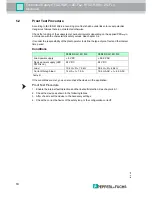
2
018-
06
12
Functional Safety KFD2-RSH-1.2D.FL2, KFD2-RSH-1.2D.FL3
Planning
3.4
Characteristic Safety Values
The characteristic safety values like PFD, PFH, SFF, HFT and T
1
are taken from the
FMEDA report. Observe that PFD and T
1
are related to each other.
The function of the devices has to be checked within the proof test interval (T
1
).
Parameters
Characteristic values
Assessment type and documentation
Full assessment
Device type
A
Mode of operation
Low demand mode or high demand mode
Safety function
Output is de-energized (DTS, de-energized to safe)
HFT
0
SIL (SC)
3
SILCL
3
PL
e
s
1
1
"No effect failures" are not influencing the safety function and are therefore not included in SFF and in the failure rates of the safety
function.
453 FIT
dd
0 FIT
du
2
2
While the diagnostic function is signaling the dangerous failure of one relay, the other two redundant relays continue to provide the
safety function. Exceptions are common cause failures that disrupt all three relays. While the diagnostic function is signaling the
failure, the probability of a dangerous undetected failure for the remaining two relays is increasing to 2.0 FIT.
0.86 FIT
total (safety function)
1
454 FIT
total
1735 FIT
SFF
1
99.8 %
MTBF
3
3
acc. to SN29500. This value includes failures which are not part of the safety function/MTTR = 8 h. The value is calculated for one
safety function of the device.
66 years
MTTF
d
1115 years (high)
DC
avg
4
4
Enable the internal fault detection to achieve a diagnostic coverage of 95.3 %. See chapter 5.1.
95.3 %
PTC
95.3 %
PFH
8.55 x 10
-10
1/h
PFD
avg
for T
1
= 1 year
5
5
Since the current PTC value is < 100 % and therefore the probability of failure will increase, calculate the PFD value according to the
following formula:
PFD
avg
= (
du
/ 2) x (PTC x T
1
+ (1
–
PTC) x T
service
)
A service time T
service
of 10 years was assumed for the calculation of PFD
avg
.
5.36 x 10
-6
PFD
avg
for T
1
= 2 years
4
8.95 x 10
-6
PFD
avg
for T
1
= 3 years
4
1.25 x 10
-5
Reaction time
6
6
Time between fault detection and fault reaction.
< 2 s
Table 3.1










































